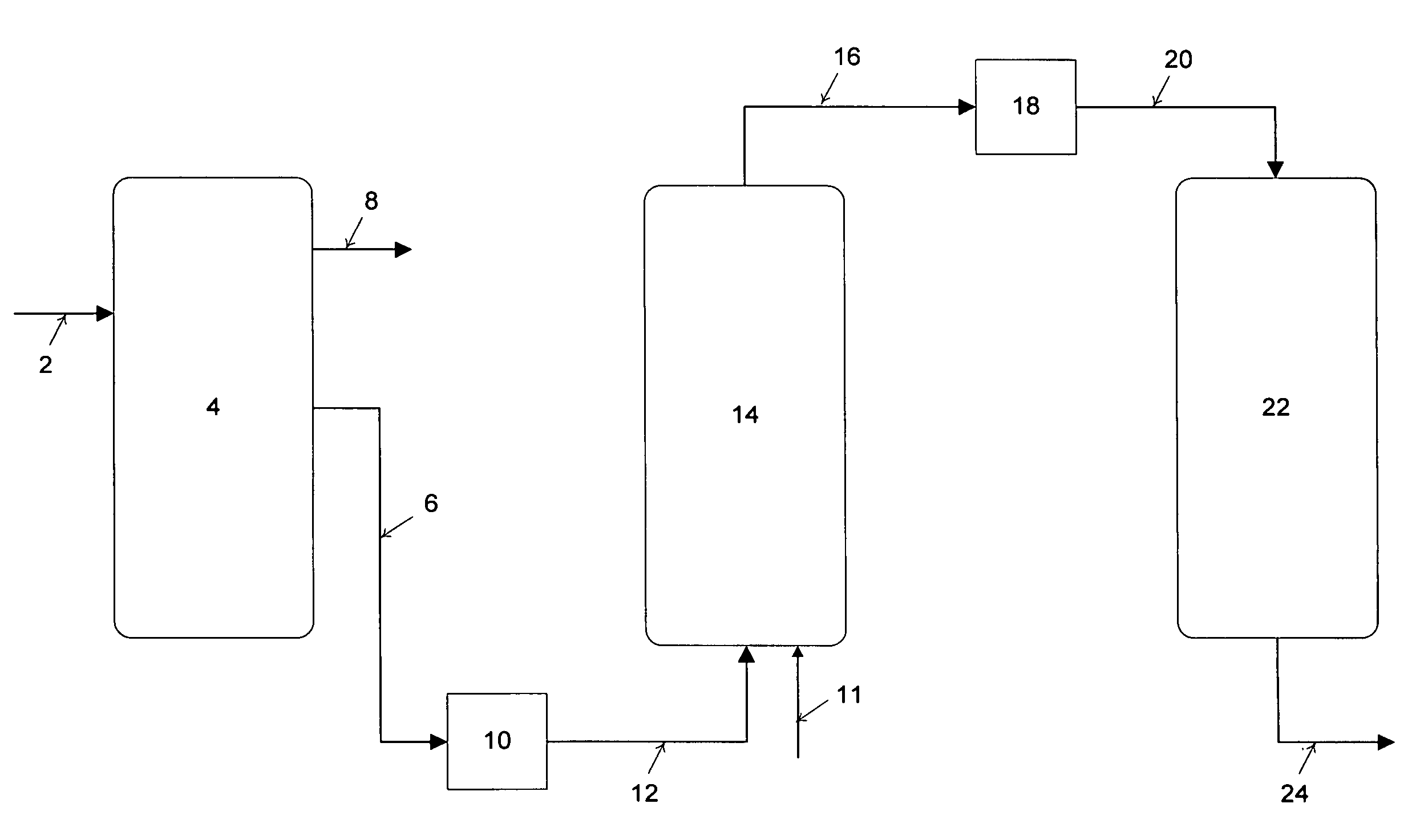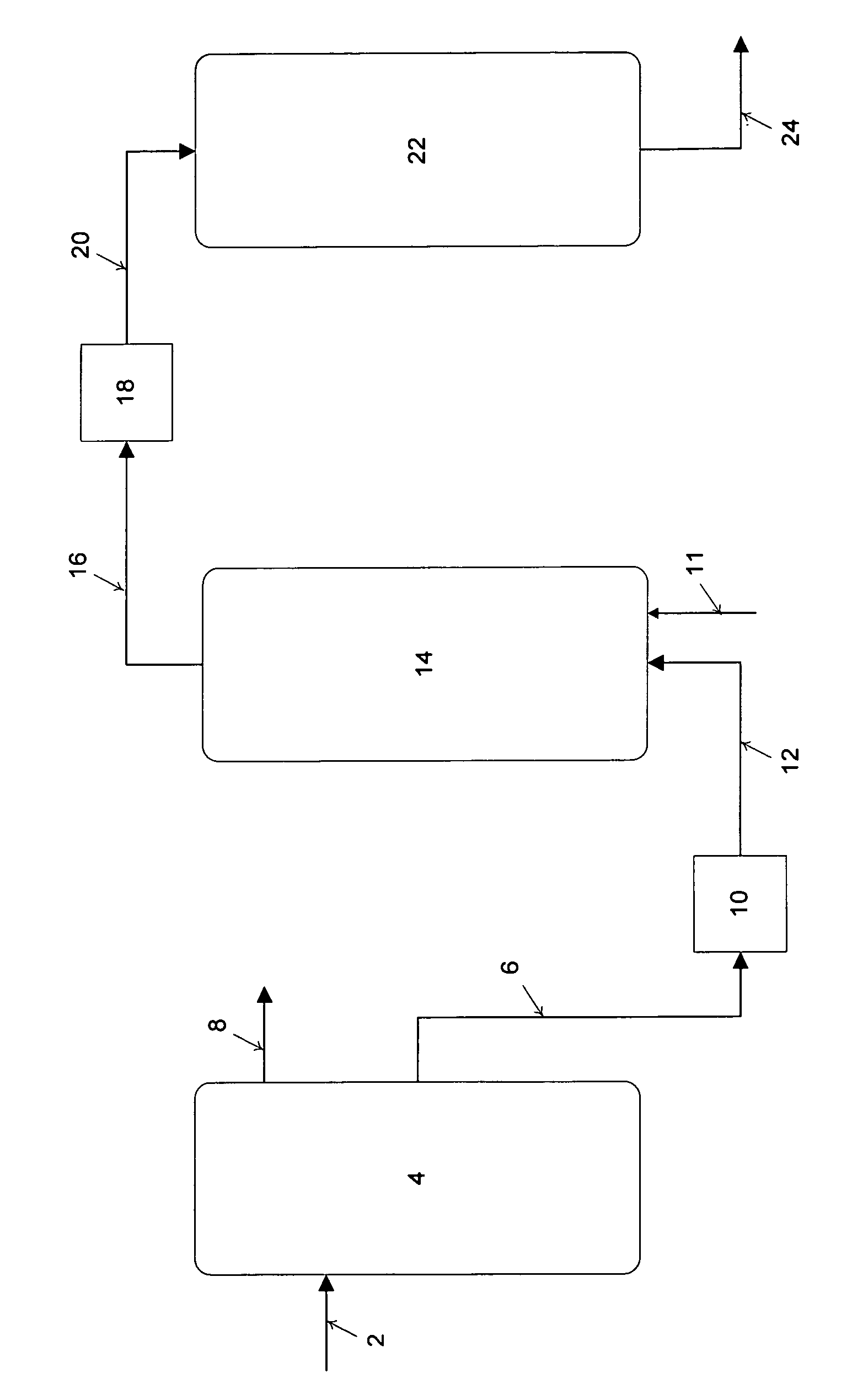Process for removing contaminants from Fischer-Tropsch feed streams
a technology of fischer-tropsch and feed streams, which is applied in the direction of chemistry apparatus and processes, metal processing, organic chemistry, etc., can solve the problems of concentrated concentration of unfilterable aluminum contaminant, and achieve the effects of reducing pressure drop, reducing pressure drop, and reducing pressure drop
- Summary
- Abstract
- Description
- Claims
- Application Information
AI Technical Summary
Benefits of technology
Problems solved by technology
Method used
Image
Examples
example 1
[0027]A Fischer-Tropsch wax prepared using a cobalt based catalyst was filtered to remove particulates having an effective diameter of about 1.2 microns or greater. The aluminum content of the filtered wax was determined. The filtered Fischer-Tropsch wax was mixed with hydrogen and passed up-flow through a guard-bed containing an active catalyst. This catalyst contained 1.6 weight percent nickel, 6.5 weight percent molybdenum, and 1.4 weight percent phosphorous on an alumina base and was presulfided before starting the Fischer-Tropsch feed. The process conditions were 290 PSIG total pressure, hydrogen recycle gas rate of 1200 SCF gas per barrel of liquid feed, liquid hourly space velocities of 1 and 2, and at catalyst temperatures ranging between 290 degrees F. and 650 degrees F. The treated Fischer-Tropsch wax was filtered a second time using a 1.2 micron filter. The filtered product was analyzed for aluminum content. The results are shown in Table 1 below.
[0028]
TABLE 1Al ppm inAl ...
example 2
[0030]The experiment of Example 1 was repeated using five different Fischer-Tropsch wax fractions containing various levels of aluminum contaminants. Liquid hourly space velocities for the tests ranged between 1 and 3. The results are shown in Table 2.
[0031]
TABLE 2WaxAl ppm inAl ppm inSampleTest #LHSVTemp. ° F.Feed1Product2A72.0675180.7B82.067543.80.7B92.065043.815.0B103.067543.816.0B113.070043.81.8C123.060043.936.0C132.067543.93.9C142.068043.94.1D152.069048.71.6D161.569048.71.8D171.069048.71.2E181.069044.111Aluminum content expressed as elemental metal present in the filtered feed to the guard-bed.2Aluminum content expressed as elemental metal present in the product recovered from the second filter step.
[0032]The results shown in Table 2 generally support the conclusions drawn from the data in Table 1. Note that in order to achieve less than 5 ppm of aluminum at a LHSV of 2.0 or higher, a temperature of 675 degrees F. is required. At higher space velocities the efficiency of the ca...
PUM
| Property | Measurement | Unit |
|---|---|---|
| effective diameter | aaaaa | aaaaa |
| diameter | aaaaa | aaaaa |
| size | aaaaa | aaaaa |
Abstract
Description
Claims
Application Information
 Login to View More
Login to View More - R&D
- Intellectual Property
- Life Sciences
- Materials
- Tech Scout
- Unparalleled Data Quality
- Higher Quality Content
- 60% Fewer Hallucinations
Browse by: Latest US Patents, China's latest patents, Technical Efficacy Thesaurus, Application Domain, Technology Topic, Popular Technical Reports.
© 2025 PatSnap. All rights reserved.Legal|Privacy policy|Modern Slavery Act Transparency Statement|Sitemap|About US| Contact US: help@patsnap.com


